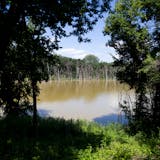Beetles are obliterating forests throughout the West, draining budgets as property values decline and threatening tourism at national parks, including Mount Rushmore.
Voters in Colorado raised taxes to protect ski resorts that bring in $3 billion annually to the economy. Pine beetles, each the size of a rice grain, have devoured 25 percent of trees in South Dakota's Black Hills, pinching the $2 billion-a-year tourism industry.
"It's difficult to stop the spread," said Bill Smith, a South Dakota Agriculture Department conservation program administrator. "What we're trying to do is slow it down."
The beetles' vast economic impact is emerging two decades into an epidemic fueled by climate change, overstocked forests and drought that wiped out 38,000 square miles — the size of Indiana and Rhode Island combined. As forests of ruined trees dominate vistas in the Rockies, Tetons, Cascades and Sierras, officials are searching for ways to counter the devastation.
"There is always the question: When is the Forest Service going to take all the dead trees away?" said Catherine Ross of Colorado's Winter Park Chamber of Commerce. "I talk to them about the enormity of the problem. There are just so many dead trees."
Infestation and disease threaten 94 national forest areas in 35 states, U.S. Agriculture Secretary Tom Vilsack said in May. The Forest Service is designating 45 million acres for priority restoration.
Colorado Gov. John Hickenlooper, a Democrat, said in a letter to Vilsack that seven of the state's 13 national forests have "experienced such massive infestation of beetles … they merit designation in their entirety."
Scientists say climate change is to blame: Winters haven't been cold enough to reduce beetle populations. The average U.S. temperature has increased as much as 1.9 degrees since 1895, according to the National Climate Assessment issued in May.



